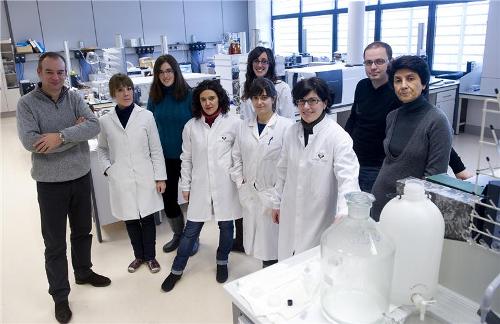The METABOLOMIPs group at the University of the Basque Country (UPV/EHU) has recently developed an innovative technique to detect gunshot residues for forensic application. The group mainly focuses on the field of forensic sciences and includes food technologists, pharmacists, chemists and others.
 From left to right: Ramón J. Barrio, Laura Millán, Raquel Gutiérrez, M. Carmen Sampedro, Itsaso Basozabal, Deiene García, Nora Unceta, Alberto Gómez and M. Aranzazu Goicolea. Not present: Alicia Sánchez and Zuriñe Ábrego. (Caption: Raúl Bogajo / Argazki Press).
From left to right: Ramón J. Barrio, Laura Millán, Raquel Gutiérrez, M. Carmen Sampedro, Itsaso Basozabal, Deiene García, Nora Unceta, Alberto Gómez and M. Aranzazu Goicolea. Not present: Alicia Sánchez and Zuriñe Ábrego. (Caption: Raúl Bogajo / Argazki Press).
One part of the group works on the biological fluids associated with drugs or forensics, which is referred as metabolites, and another section works on the electrochemical sensors, known as molecularly imprinted polymers (MIPs), to analyze the metabolites.
The detection of gunshot residues is utilized to identity the individual who pulled the trigger or to differentiate between a murder and a suicide. The new methodology provides better cost and time benefits than the currently used method in forensic laboratories. The existing gunshot residue detection method is based on electron microscopy and the time taken to perform every single investigation using this method ranges from 8 to 10 h. In addition, this technique is very expensive. METABOLOMIPs has developed an alternative solution to carry out reliable analysis within an hour.
The new method uses a combination of laser ablation and mass spectrometry (LA-ICPMS) for gunshot residue detection. In the first step, the inorganic residues are collected from the skin of the individual, who is suspected of firing. The materials are then extracted from the skin’s surface using the laser, and the mass spectrometry measures the metals and isotopes present in it. The breakthrough method will enable the detection of smaller residues and would be a low-cost and effective alternative than the existing technique. In addition, this method will perform the detection in less than 66 minutes.